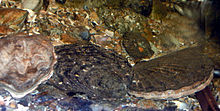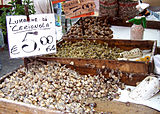Pecten maximus
| Pecten maximus | |
|---|---|

| |
| Two beachworn upper (flat) valves of Pecten maximus from Wales | |
| Scientific classification | |
| Domain: | Eukaryota |
| Kingdom: | Animalia |
| Phylum: | Mollusca |
| Class: | Bivalvia |
| Order: | Pectinida |
| Family: | Pectinidae |
| Genus: | Pecten |
| Species: | P. maximus
|
| Binomial name | |
| Pecten maximus | |
| Synonyms[1] | |
| |
Pecten maximus,
Description
The shell of Pecten maximus is quite robust and is characterised by having "ears" of equal size on either side of the apex. The right, or lower, valve is convex and slightly overlaps the flat left, or upper, valve, which is flat. Larger specimens have a nearly circular outline and the largest may measure 21 cm in length. The "ears" are prominent and are a minimum of half the width of the shell with the byssal notch situated in the right anterior ear being slight and not serrated. The sculpture of the valves is distinctive and consists of 12 to 17 wide radiating ribs and numerous concentric lines which clearly show the scallop's growth history, while the "ears" show a few thin ribs which radiate from the beaks. The radiating ribs reach the margins of the valves and this creates a crenulated form. The left valve is normally reddish-brown while the right valve varies from white through cream to shades of pale brown contrasting with pink, red or pale yellow tints; either valve may show zigzag patterns and may also show bands and spots of red, pink or bright yellow.[3]
The colour of the body of Pecten maximus is pink or red with the mantle marbled brown and white. When young they are attached to the substrate by a
Distribution
Pecten maximus occurs in the eastern Atlantic along the European coast from northern
Biology

Pecten maximus frequently creates a slight hollow in the substrate for its shell to lie in by opening and closing the valve to eject water from the mantle cavity, which raises the shell at an angle to the substrate so that subsequent water jets into the sediment and create a recess.
Pecten maximus swims but this is generally limited to escape reactions. The main predators which cause this reaction when detected are the mollusc eating
Pecten maximus tends to be more numerous in areas where they are not fully exposed to strong currents. Scallops which live in sheltered habitats grow faster than scallops in areas exposed to wave action, possibly due to the filter feeding apparatus being unable to function because of high concentrations of particulate matter in the water in areas subject to high levels of wave exposure. Another factor that may be significant is that the processes of larval settlement and byssal attachment are rather delicate and would be disturbed in strong currents. Abundance and growth rates are negatively correlated with the amount of mud in the substrate.[3]
Scallops use larval motility to distribute themselves, as the adult scallops have limited mobility. The distribution of the larvae is affected by factors such as local hydrographic regimes and their survival, and this results in the scallops having an aggregated distribution within their geographic range. This means that the major fishing grounds are normally widely separated and each fishing ground's environmental conditions mean there are marked differences in structures of the populations, although the genetics of scallops are rather uniform across its range.[5]
The reproductive cycle of Pecten maximus is extremely variable and the spawning may be influenced by both internal and external factors such as age and temperature respectively but is also influenced by genetic adaptation. Generally, mature scallops spawn over the summer months starting in April or May and lasting to September. They are hermaphroditic and have distinct tongue-shaped gonads which are red or orange in colour for the female gonad and white for the male.[6] It is estimated that a three-year-old scallop releases 15–21 million oocytes per emission. There appear to be two spawnings in many parts of the range, normally there is a partial one in the Spring and a full one in late August, however younger scallops have a single spawning event in the late summer. In some areas this pattern is reversed and the major spawning is in the Spring. After spawning the animals undergo period of recovery of the gonad before they spawn again. Fertilization of the gametes is external and either sperm or oocytes can be released into the water column first.[5]
Since the larval stage of Pecten maximus is relatively long, up to a month, the potential for dispersal is quite high, even smaller adults can use the byssus to drift too. However, in at least some populations, genetic studies show that there is little contribution from more distant populations and that these populations probably sustain themselves.[5]
In waters around the United Kingdom Pecten maximus become sexually mature at around 2–3 years old and when they reach 80 to 90 mm in shell length. Where they are not exploited, they may live for more than 20 years and reach shell lengths of more than 200mm.[7] Scallops in shallow water grow faster than those in deeper water; the growth halts in winter and starts again in spring, producing concentric growth rings which are used to age the scallops.[5]
Genomics
A draft
Predators and diseases
As well as Asterias rubens and Astropecten irregularis major predators on Pecten maximus are crabs such as
The larvae of Pecten maximus are attacked by the bacterium Vibrio pectenicida, which was described in 1998 as a new species after incidents of mortality among cultured scallops in France in the early 1990s.[12] Other strains of pathogenic bacteria were detected in Norway following mass mortality of larvae in culture.[13]
Fisheries and aquaculture
In 1999 the total catch reported by the United Nations Food and Agriculture Organisation was 35,411 tonnes with the two biggest catches being reported from the
Pecten maximus can be cultivated in aquaculture and this is reasonably advanced in France[15] and Norway.[16] Spain, France, Ireland, the United Kingdom and Norway have been involved in the aquaculture of scallops; production peaked in 1998 when 512 tonnes were landed but production later decreased, with only 213 tonnes landed in 2004, having an estimated value of €852 000, equivalent to €4 per kilogramme.[6]
Pecten maximus has been found to contain
Cultural significance
The oil company Shell plc derives its highly recognizable logo from this species.[17]
Pilgrims travelling to the town of
See also
References
- ^ a b "Pecten maximus (Linnaeus, 1758)". World Registry of Marine Species. Retrieved 1 January 2017.
- S2CID 84757441.
- ^ Food and Agriculture Organization of the United NationsDepartment of Fisheries and Aquaculture. Retrieved 1 January 2017.
- ^ a b "Mollusca of the North Sea M.J. de Kluijver, S.S. Ingalsuo & R.H. de Bruyne Pecten maximus". Marine Species Identification Portal. ETI BioInformatics. Retrieved 1 January 2017.
- ^ a b c d e f g h "BIOTIC Species Information for Pecten maximus". BIOTIC (Biological Traits Information Catalogue). MarLIN (Marine Life Information Network). Retrieved 1 January 2016.
- ^ a b c A. Beaumont; T. Gjedrem (2007). Scallops - Pecten maximus and P. jacobaeus (Report). Genimpact. Retrieved 1 January 2017.
- ^ a b Bryce D. Beukers-Stewart; Joanne S. Beukers-Stewart (2009). Principles for the Management of Inshore Scallop Fisheries around the UK (PDF) (Report). University of York. Retrieved 1 January 2016.
- ^ PMID 33813884.
- ^ S2CID 215774459.
- S2CID 84831172.
- .
- PMID 9731288.
- S2CID 20819269.
- PMID 11153135.
- ^ Nicole Devauchelle; Christian Mingant (1991). "Review of the reproductive physiology of the scallop, Pecten maximus, applicable to intensive aquaculture" (PDF). Aquatic Living Resources. 2: 41–51.
- S2CID 45170157.
- ^ a b "Great scallop". Ecomare. Archived from the original on 1 January 2017. Retrieved 1 January 2016.
Lat: Pecten Maximus Eng: St James scallop
- S2CID 15055718.



